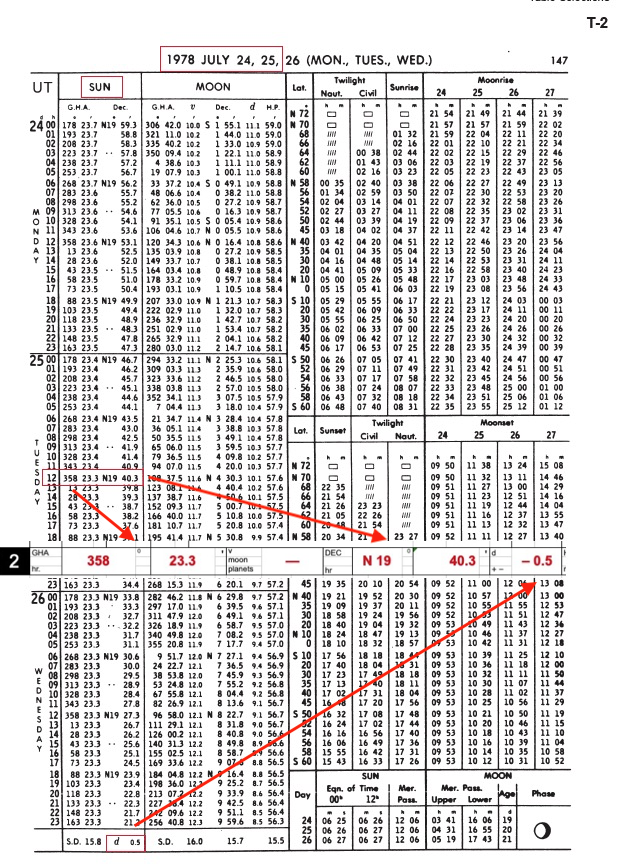Here is the exercise:
For this exercise we use the 1978 Almanac data from our textbook, but we have to use a full set of Increments and Corrections and we need a full set of Pub 249 vol 2.
Forms, Sight Reduction Tables, Increments and Corrections, and indeed even the Almanac data can be found at starpath.com/celnavbook.
Below is the filled out form, which is the answer to the question, followed by notes on where each of the values come from. We ask our students to follow through on this example to understand each step following the instructions in Chapter 3 of the textbook, which covers each Box in the form. We also have a book (Starpath Celestial Navigation Work Forms) that explains our forms step by step, with several examples. It is effectively a short course on cel nav.
Below is just a very short discussion, not intended to replace what is in the textbook.
Box 1 is the sight data, all given for any sight.
Box 2 and 3 are the look ups for the GP of the sun at sight time. first the whole hours part from the daily pages of the Almanac, then the minutes and seconds correction from the Increments and corrections tables.
Increments and corrections for Box 3.
Add up hour and min-sec parts to get GHA. Then choose the assumed position (AP = a-Lat, a-Lon). Round the DR-Lat to nearest whole degree to get a-Lat, which is 38º N. Then choose the a-Lon to be the closest Lon to the DR-Lon that has the same minutes as the GHA. In this case a-Lon = 1º 55.6'W. We cannot use 45º 55.6' because that one is more than 30' from the DR Lon. (We have extended practice with choosing the a-Lon in Section 11.13 in the textbook.)
With these values we can then find final LHA = GHA – a-Lon, and fill Box 4 that we need for the sight reduction tables and then turn to Pub 249, Vol 2 for Lat 38, Same Name, Dec = 19, LHA = 317. which we find on the page below.
Now we get the correction to Hc based on d value and Dec minutes. Then we add this correction to tabulated Hc to get final Hc, completing Box 5. Hc = 48º 34.2'
Now we do the right side of the form to convert Hs to Ho, and then we compare Ho to Hc to get the a-value. Plus convert Z to Zn and we are done.
For the IC we use the rule "if it is on, we take it off," so this is -1.0'. We find the dip and altitude corrections from the Nautical Almanac page shown below:
To find the correct altitude correction, first note the date. We are July which is between April and Sept. Then check we are Lower Limb, then go down the column to find Ha. We always want the center of the body, so LL means this is a + correction; UL this will be a – correction.
Now use the rules on the form and on every sight reduction tables page that tells us how to convert from Z to Zn, as in previous image.
Then subtract Ho and Hc, smaller from larger and that is the a-value and take the label next to the largest. In this case our LOP is a = 11.6A from 105T. We plot this from the AP 38N, 44 55.6W.
You can always check your work with Celestial Tools, SR & Fix function as shown below:
This shows all the values you should get on intermediate steps. Note that Celestial Tools rounds dec and dec corrections to whole minutes, which is the official Pub 249 procedure. We get slightly different values as we interpolated the d correction. (In this case we end up about 0.2' more accurate than had we rounded. In other cases it could be as much as twice that better, but indeed in a few cases, this rounding will make things worse by a couple tenths.)









No comments:
Post a Comment